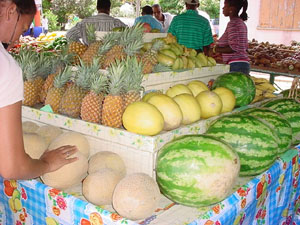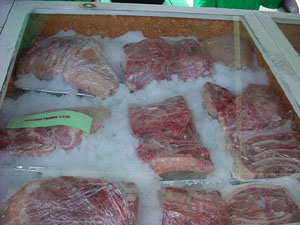|
|
|
|
|
|
|
|
|
 |
|
Photos of local fruits, vegetbales and meats on display at last month's Agricultural Exhibition in St. Kitts. (Photos by Erasmus Williams) | BASSETERRE, ST. KITTS, MAY 28TH 2006 - A mixed performance in the Federation's agricultural sector in 2005 with several problems plaguing food crop and livestock production. According to the Caribbean Development Bank (CDB) agricultural production in St. Kitts and Nevis declined in 2005 due mainly to adverse weather conditions, which affected crop growth and resulted in reduced yields.
Heavy rainfall in October/November of 2004 and dry conditions during February and March 2005 impacted negatively on crop production and the high incidence of pests and diseases also adversely affected productivity. CDB said value-added in the agriculture sector declined by an estimated 3.9 percent in 2005 compared to a growth of 11.7 percent in the previous year. Sugar-cane production fell by 16 percent in 2005 with a lower acreage planted, while food crop production declined by an estimated 10.1 percent compared with a growth of 6.3 percent in 2004.
It said that lower crop production in 2005 reflected declines in almost all categories of production except yam. Production declined by over 25 percent for cabbages, sweet peppers, onions and white potatoes. The high incidence of black rot disease and diamond black moth resulted in the decline in cabbage production. The yellow leaf curls virus also adversely affected tomato production. Lower production of white potato was due mainly to the decline in the area planted resulting from higher cost of seeds.
 |
|
Photos of local fruits, vegetbales and meats on display at last month's Agricultural Exhibition in St. Kitts. (Photos by Erasmus Williams) | The lower production levels from the Estridge irrigation project contributed to the decline in the level of agriculture production. Value-added in the livestock industry increased marginally by an estimated 2.1 percent, compared with growth of 10.9 percent in 2004, reported the Barbados-based financial institution. Pork production increased significantly to 68,000 kgs in 2005 from 61,900 kg in 2004 due to improved husbandry practices facilitated by training workshops and extension services by the Department of Agriculture.
In contrast, beef and mutton production were lower in 2005 despite improved extension services and the continued promotion of the marketing initiative in the use of locally produced meat. Beef production declined from 121,700 kgs in 2004 to 85,000 kgs in 2005, as many farmers were reluctant to slaughter their animals. Mutton production declined by 7 percent to 8,900 kgs in 2005, while goat meat declined by 17 percent to 11,300 kgs.
The report said that the livestock industry continued to be plagued by several constraints including insufficient lands for livestock farming, the high incidence of canine attacks, increasing incidence of praedial larceny, absence of pipe-borne water and poor commercial approaches by livestock farmers.
Value-added in the fisheries sub-sector decelerated by 8.5 percent in 2005 following substantial growth of 31.5 percent in 2004, reflecting increases in the catch of high priced pelagic such as snapper, dolphin, tuna and conch. CDB said that the Old Road Fisheries Complex, funded by the Government of Japan, is presently in its first phase of construction and its completion in 2006 is expected to boost fish production in St. Kitts and Nevis significantly. |
|
|
|
|
|
|
|